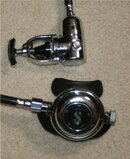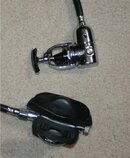[...]EPDM has better physical properties and only a somewhat lower ignition temp.[...]
This has been a view in the dive industry that has slowly changed over the last few decades. I would argue that EPDM is, if at all only marginally better than NBR for oxygen service. The reason is that it has a rather low auto-ignition temperature, only slightly better than NBR, occasionally worse. But at the same time, it develops a tremendous heat upon combustion. In fact, it develops one of the highest temperatures of any elastomer used in O-rings. This means its rather easy to ignite and then burns really really hot if it does.
| Name | Auto Ignition Temperature °C | Heat Of Combustion J/g | O2 Index % |
| EPDM | 150–200 | 47,200 | 25.5 |
| Nylon 6/6 (polyamide) | 178 | 32,200 | 36 |
| Zytel 42 (polyamide) | 192 | 37,000 | |
| Buna-N (Nitrile rubber) | 173 | 35,600 | 22 |
| Hydrocarbon Greases | 160–220 | 33,500–41,900 | 21 |
| Polyurethane | 181 | 21,800–27,200 | 22 |
| PEEK | 305 | 32,500 | 35 |
| FKM (Viton) | 300–325 | 12,600–20,900 | 56–100 |
| PTFE (Teflon) | >427 | 4,200–7,100 | 95–100 |
| Krytox (Perfluorinated lubricant) | >427 | 3,800–4,200 | DNI |
From ASTM: STP 1522
Manufacturers went through a hype of using EPDM, but this has ebbed down in the last decades, as it became clear that EPDM is not at all suitable in high oxygen environments.
The real strength of EPDM lies in its resistance to the environment. It is very resistant to ozone and weathering conditions, which is why it is extensively used in roofing applications and finds its way onto the wiper blade of your car. But these characteristics are of no real interest for the SCUBA market. What is interesting for us is that EPDM is very resistant to abrasion and has a rather high resistance to tears, so it lends itself exceptionally well to dynamic O-rings.
Source: Parker O-ring Handbook (2007)
These two areas, abrasion resistance and tear resistance, are where it is superior to NBR. But for almost all applications in SCUBA, leaving a few dynamic or tiny O-rings under high pressure aside, NBR is sufficient. Unfortunately, EPDM is utterly misplaced in high oxygen environments. I believe the myth that it is well suited for high oxygen systems stems from the fact that the material is extensively used by Apeks. And a lot of tech divers use Apeks regulators and, of course, use plenty of high oxygen systems.
You will not make your system magically ignite by using EPDM O-rings instead of FKM O-rings. But what you are doing is adding something to the long chain of things that have to go wrong for an oxygen fire to start and sustain itself.
EPDM O-rings are completely fine for oxygen service, as long as nothing else goes wrong. Incidentally, so are NBR O-rings. But the bit about nothing else going wrong is the really important bit.
An oxygen fire is like a seesaw. For an oxygen fire to occur, several things need to go wrong. As long as I'm doing the right things, like maintaining a clean system, using oxygen-compatible lubricants, slowly opening valves, selecting proper O-ring materials, and so on, the system remains safe.
However, if I cut corners, such as using improper O-ring polymers, incompatible lubricants, a contaminated system, or quickly slamming open valves, the balance shifts. Each of these missteps adds a small weight to the "wrong" side of the seesaw.
The seesaw represents the balance between safety and risk. On one side, you have all the precautions and best practices (the "right" side), and on the other, you have the potential hazards (the "wrong" side). Initially, the "right" side is heavier, keeping the system safe. But with each improper action, a small weight is added to the "wrong" side. Individually, these weights may not be enough to tip the seesaw, but collectively, they can shift the balance. Eventually, if enough weights accumulate, the seesaw tips to the "wrong" side, and an oxygen fire can occur. And EPDM is squarely on the wrong side of this seesaw. Despite the ASTM source, I would even place it below NBR in oxygen compatibility, due to its high combustion energy.
In essence, no single misstep is solely responsible for the fire; it's always a combination of several factors that, when added together, create the tipping point. Using FKM for O-rings, for example, does not suddenly exempt me from adhering to best practices. Sure, FKM is more tolerant, but if I do enough other things wrong, it will happily ignite.





